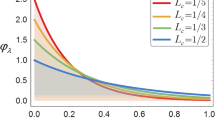Abstract
The problem of refined modeling of ultrafine rods, which arose in connection with the need to explain the known experimental data on the significant dependence of the bending stiffness of such ultrathin structures on their thickness if the thickness becomes very small, commensurate as some authors believe with the characteristic dimensions of the material microstructure, is considered. To simulate such effects, Kirchhoff’s theory of thin rods uses gradient theories, nonlocal, micropolar elasticity theories, including scaled construction parameters. However, the obtained simulation results are very contradictory; the question of the reliability of the obtained results and the nature of the scale-dependent effect of the effective bending properties of ultrathin rods remains unresolved. It is shown in the paper that these effects for Kirchhoff and Timoshenko rods can be explained by taking into account the surface properties for ultrathin rods (plates).
Similar content being viewed by others
REFERENCES
F. Yang, A. C. M. Chong, D. C. C. Lam, and P. Tong, “Couple stress based strain gradient theory for elasticity,” Int. J. Sol. Struct. 39, 2731–2743 (2002).
C. M. Wang, Y. Y. Zhang, and X. Q. He, “Vibration of nonlocal Timoshenko beams,” Nanotechnol. 18, 105401 (2007).
H. M. Ma, X.-L. Gao, and J. N. Reddy, “A microstructure-dependent Timoshenko beam model based on a modified couple stress theory,” J. Mech. Phys. Solids 56 (12), 3379–3391 (2008).
H. M. Ma, X.-L. Gao, and J. N. Reddy, “A non-classical Mindlin plate model based on a modified couple stress theory,” Acta Mech. 220 (1–4), 217–235 (2011).
S. Kong, S. Shou, Z. Nie, and K. Wang, “Static and dynamic analysis in micro-beams based on strain gradient elasticity,” Int. J. Eng. Sci. 47 (4), 487–498 (2009).
K. A. Lazoupulos and A. K. Lazoupulos, “On a strain gradient elastic Timoshenko beam model,” ZAMM 91, 591–882 (2011).
S. Kakunai, J. Masaki, R. Kuroda, et al., “Measurement of apparent Young’s modulus in the bending of cantilever beam by heterodyne holographic interferometry,” Exp. Mech. 25 (4), 408–412 (1985).
D. C. C. Lam, F. Yang, A. C. M. Chong, et al., “Experiments and theory in strain gradient Elasticity,” J. Mech. Phys. Solids. 2003. V. 51. P. 1477–1508 (2003).
A. W. Mc Farland and J. S. Colton, “Role of material microstructure in plate stiffness with relevance to microcantilever sensors,” J. Micromech. Microeng. 15 (5), 1060–1067 (2005).
C. Liebold and W. H. Muller, “Measuring material coefficients of higher gradient elasticity by using AFM techniques and Raman-spectroscopy,” Adv. Struct. Mater. 22, 255–271 (2013).
R. Lakes and W. J. Drugan, “Bending of a Cosserat elastic bar of square cross section: Theory and experiment,” J. Appl. Mech. 82 (9), 091002 (2015).
R. Lakes, “Experimental methods for study of Cosserat elastic solids and other generalized elastic continua,” in Continuum Models for Materials with Micro-Structure, Ed. by H. Mühlhaus and J. Wiley (New York, 1995), Ch. 1, pp. 1–22.
S. A. Lurie and Y. O. Solyaev, “Revisiting bending theories of elastic gradient beams,” Int. J. Eng. Sci. 126, 1–21 (2018).
E. V. Lomakin, S. A. Lurie, L. N. Rabinskiy and Y. O. Solyaev, “Semi-inverse solution of a pure beam bending problem in gradient elasticity theory. The absence of scale effects,” Dokl. Phys. 63 (4), 161–164 (2018).
S. A. Lurie, D. B. Volkov-Bogorodsky, P. A. Belov, and E. D. Lykosova, “Do nanosized rods have abnormal mechanical properties? On some fallacious ideas and direct errors related to the use of the gradient theories for simulation of scale-dependent rods,” Nanomech. Sci. Technol.: Int. J. 7 (4), 261–295 (2016).
S. Lurie, Y. Solyaev, A.Volkov, and D. Volkov-Bogorodskiy, “Bending problems in the theory of elastic materials with voids and surface effects,” Mat. Mech. Solids 23 (5), 787-804 (2017).
S. Papargyri-Beskou, K. G. Tsepoura, D. Polyzos, and D. E. Beskos, “Bending and stability analysis of gradient elastic beams,” Int. J. Solids Struct. 40 (2), 385–400 (2003).
K. A. Lazopoulos, “Post-buckling problems for long elastic beams,” Acta Mech. 164 (3–4), 189–198 (2003).
K. A. Lazopoulos and A. K. Lazopoulos, “Stability of a gradient elastic beam compressed by non-conservative forces,’ ZAMM 90 (3), 174–184 (2010).
P. A. Belov and S. A. Lurie, “Mathematical theory of damaged media. Gradient theory of elasticity. Formulations hierarchy comparative analysis”, in Analysis and Applications (Palmarium Academic Publishing, 2014).
A. A. Gusev and S. A. Lurie, “Symmetry conditions in strain gradient elasticity,” Math. Mech. Solids 22 (4), 683-691 (2015).
V. V. Vasiliev and S. A. Lurie, “On correct nonlocal generalized theories of elasticity,” Phys. Mezomech. 19 (3), 269-281 (2016).
X .L .Gao and S. K. Park, “Variational formulation of a simplified strain gradient elasticity theory and its application to a pressurized thick-walled cylinder problem,” Int. J. Sol. Struct. 44 (22–23), 7486–7499 (2007).
P. A. Belov and S. A. Lurie, “Theory of ideal adhesion interactions,” J. Compos. Mech. Des. 14, 545–561 (2007).
S. Lurie, P. Belov, and E. Lykosova, “Extended model of surface-related effects in second gradient elasticity. Surface waves related to the nature of adhesion,” in Nonlinear Wave Dynamics of Materials and Structures, Ed. by H. Altenbach, V. A. Eremeyev, I. S. Pavlov, and A. V. Porubov, (Springer, Cham, 2020).
V. A. Eremeyev, “On effective properties of materials at the nano- and microscales considering surface effects,” Acta Mech. 227, 29–42 (2016).
C. Liebold and W. H. Muller, “Applications of strain gradient theories to the size effect in submicro-structures incl. Experimental analysis of elastic material parameters,” Bull. TICMI 19 (1), 45–55 (2015).
C. Liebold and W. H. Muller, “Comparison of gradient elasticity models for the bending of micromaterials,” Comput. Mater. Sci. 116, 52–61 (2016).
Funding
This work was carried out under the financial support of the Russian Foundation for Basic Research grant no. 18-01-00553a and state assignment of the Institute of Applied Mechanics of Russian Academy of Sciences AAAA-A17-117032010137-0.
Author information
Authors and Affiliations
Corresponding author
Additional information
Translated by M. K. Katuev
About this article
Cite this article
Lur’ye, S.A. On the Paradox of Anomalous Relative Bending Stiffness of Ultrathin Beams in the Gradient Theory of Elasticity. Mech. Solids 55, 340–347 (2020). https://doi.org/10.3103/S0025654420030085
Received:
Revised:
Accepted:
Published:
Issue Date:
DOI: https://doi.org/10.3103/S0025654420030085



